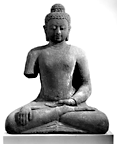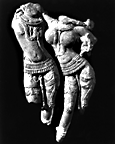Asian Arts | Sacred Realm Exhibition
![]()
An Exhibition of Indian Sculpture
From 2nd century B.C. to 13th century A.D.
Text and images © Rossi and Rossi: not to be reproduced without permission
|
Anna Maria Rossi and Fabio Rossi are presenting 'Sculpture from a Sacred Realm', a fascinating exhibition celebrating the splendour of Indian sculpture. The 24 works, dating from 2nd century B.C. to 13th century A.D, vividly reveal the central role religious sculpture played in Indian civilisation. India's three main faiths - Hinduism, Buddhism and Jainism developed side by side, responding to the same influences and exchanging ideas and insights. a is is evident in Indian art with workshops providing sculpture as readily for a Hindhu temple as for a Buddhist or Jain one. While it is extremely rare for an individual artist to be identified, the productions of workshops can be recognised by regional and stylistic characteristics and the media employed. This exhibition closely complements 'The Peaceful Liberators: Jain Art from India', which opens at the Victoria and Albert Museum this autumn after touring the United States. Rossi & Rossi Ltd., respected dealers in Oriental Art for more than 25 years, are co-sponsors with Sotheby's of an international symposium organised by the V & A entitled 'Jainism: Religion, Ritual and Art' on 24 and 25 November 1995. One of the earliest pieces in 'Sculpture from a Sacred Realm' is an impressive relief from north-east India depicting a female figure. Intricately carved from the underside of a tortoise-shell, it is dated by its style and by radiocarbon analysis to circa 200 B.C., a formative period of Indian art. This magnificent figure, with her elaborate head-dress and tasselled skirt, is accompanied by an attendant carrying a large fan and surrounded by rosettes, an exotic bird and large lotus flowers. Examples of bone and ivory carving from ancient India are known but this remarkable tortoise-shell relief is thought to be unique for its size. The identity of the figure is enigmatic but similar representations appear on terracotta plaques of this period variously labelled as 'yakshi', 'Lakshmi' or 'mother goddess'. One of the finest of these plaques is at the Ashmolean Museum, Oxford. This exhibition also includes a superb Gandharan sculpture of two female figures, dating from 200-300 A.D. Of grey schist, these elegant figures are perhaps deities and the fluidity of the carving shows a strong Hellenistic influence, particularly in the crisp detail of their garments. The Gandhara area (now north-west Pakistan) was a central Asian frontier region ruled some time by the Greeks, which resulted in a fascinating artistic crossfertilisation. To express the idea of divinity in human form, sculptors sought inspiration from statues of Greek and Roman gods and this remarkable piece is an intriguing mix of East and West. Another rarity in this exhibition is a two-sided stele dating from the late 2nd century A.D. Rarely in the history of Indian art did stone workshops turn to secular literature for inspiration. An important exception was the Kushan Mathura region where sculptors produced a group of works depicting scenes from a popular play, 'The Little Clay Cart' written by Shudraka. An example is the double-sided relief now in the National Museum in New Delhi, which was excavated in Maholi in 1938. m e stele in this London exhibition depicts the figure of a woman being helped to her feet by a young man and an old woman. The tableau is thought to represent the moment in the last act of the play when the courtesan Vasantasena falls at the feet of the hero Charudatta. m e other side of this relief shows four women, presumably her attendants, standing beneath a canopy of foliage and fruit. E e style of this stele is sufficiently similar to that of the Maholi piece to suggest that both sculptures were probably produced by the same atelier. The lyrical nature of early Indian sculpture is evident in a superb work depicting Narayana (Vishnu) and his consort Lakshmi, Goddess of Fortune. a e sensuous nature of their relationship is conveyed in the exaggerated pose of the figures, their union playing an important role in Hindu mythology. a is sandstone sculpture dates from circa 1000-1050 A.D. and comes from the Khajuraho or eastern Uttar Pradesh region. a e drapery patterns are similar to those found on figures at the Dulao Deo Temple at Khajuraho. Another important example of Hindu sculpture is the lOth-century sandstone relief depicting Ganesha, the son of Shiva and Parvati. The Indian fondness for paradox is wonderfully captured in the mythology surrounding Ganesha, who is always portrayed with a human body and an elephant's head. The imagery of this giant of the jungle, also a stately symbol of royalty, dancing delicately was a challenge to the Indian sculptor's wit and dexterity. This piece in the Rossi & Rossi exhibition is one of the most powerful and animated representations of Ganesha in existence. A fine example of Buddhist sculpture is a bronze statue of the Bodhisattva Maitreya (the Buddha of the Future), dating from the 12th/13th century. This sensuous and highly decorated example comes from Nagapattinam in the Tanjore district of Tamilnadu, one of the last strongholds of Buddhism in India. Standing on a large lotus flower, the figure's upper right hand once held a rosary, remnants of which are still visible, while the upper left hand would have held a nagekesara flower. Four-armed images of Maitreya are extremely rare, especially from southern India. This important work was included in the major touring exhibition entitled 'The Sensuous Immortals' which was shown in Los Angeles, Seattle, Denver and Ransas City from 1977 to 1978. The exhibition is accompanied by a fully illustrated catalogue with introduction and catalogue entries by Donald M Stadtner, formerly Associate Professor at the University of Texas, Austin. |
Click on the small images to go to a full page image with caption



Text and images © Rossi and Rossi: not to be reproduced without permission


